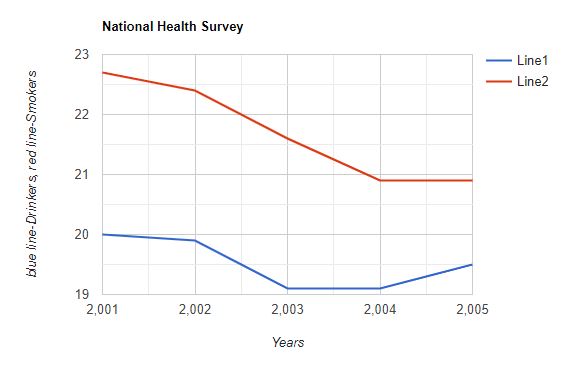Health The percents of adults who are considered drinkers or smokers are shown in the table. Drinkers were defined as those who had five or more drinks in 1 day at least once during a recent year. Smokers were defined as those who smoked more than 100 cigarettes in their lifetime and smoked daily or semi-daily. (Source: National Health Interview Survey)
Health The percents of adults who are considered drinkers or smokers are shown in the table. Drinkers were defined as those who had five or more drinks in 1 day at least once during a recent year. Smokers were defined as those who smoked more than 100 cigarettes in their lifetime and smoked daily or semi-daily. (Source: National Health Interview Survey)
Calculus: Early Transcendentals
8th Edition
ISBN:9781285741550
Author:James Stewart
Publisher:James Stewart
Chapter1: Functions And Models
Section: Chapter Questions
Problem 1RCC: (a) What is a function? What are its domain and range? (b) What is the graph of a function? (c) How...
Related questions
Topic Video
Question
Question is on photo.

Transcribed Image Text:### Health Statistics
The table below presents the percentage of adults considered drinkers or smokers over several years.
- **Drinkers** are defined as individuals who had five or more drinks in one day at least once during a recent year.
- **Smokers** are those who smoked more than 100 cigarettes in their lifetime and smoked daily or semi-daily.
**Data Source: National Health Interview Survey**
| Year | 2001 | 2002 | 2003 | 2004 | 2005 |
|---------|------|------|------|------|------|
| Drinkers (%) | 20.0 | 19.9 | 19.1 | 19.1 | 19.5 |
| Smokers (%) | 22.7 | 22.4 | 21.6 | 20.9 | 20.9 |
#### Questions:
(a) Sketch a line graph for each data set.
(b) Describe any trends that appear.
---
### Graph Description:
When sketching a line graph for this data:
- **X-axis (horizontal)**: Represents the years from 2001 to 2005.
- **Y-axis (vertical)**: Represents the percentage of adults (ranging roughly from 18% to 23%).
#### Drinkers:
- Begin at 20.0% in 2001, slightly decreasing each year, reaching 19.1% by 2003 and 2004, and then increasing to 19.5% in 2005.
#### Smokers:
- Start at 22.7% in 2001 and show a gradual decline each year, landing at 20.9% in 2004 and maintaining that level in 2005.
### Trend Analysis:
- **Drinkers**: The percentage shows a general decline from 2001 to 2004, followed by a slight increase in 2005.
- **Smokers**: There is a consistent decreasing trend from 2001 to 2005.
This data suggests a gradual reduction in both drinking and smoking rates over the years, with a small uptick in drinking in 2005.
Expert Solution
Step 1
a)
Plot the number of drinkers and smokers on the y-axis and years on the x-axis

Step by step
Solved in 2 steps with 1 images

Knowledge Booster
Learn more about
Need a deep-dive on the concept behind this application? Look no further. Learn more about this topic, calculus and related others by exploring similar questions and additional content below.Recommended textbooks for you

Calculus: Early Transcendentals
Calculus
ISBN:
9781285741550
Author:
James Stewart
Publisher:
Cengage Learning

Thomas' Calculus (14th Edition)
Calculus
ISBN:
9780134438986
Author:
Joel R. Hass, Christopher E. Heil, Maurice D. Weir
Publisher:
PEARSON

Calculus: Early Transcendentals (3rd Edition)
Calculus
ISBN:
9780134763644
Author:
William L. Briggs, Lyle Cochran, Bernard Gillett, Eric Schulz
Publisher:
PEARSON

Calculus: Early Transcendentals
Calculus
ISBN:
9781285741550
Author:
James Stewart
Publisher:
Cengage Learning

Thomas' Calculus (14th Edition)
Calculus
ISBN:
9780134438986
Author:
Joel R. Hass, Christopher E. Heil, Maurice D. Weir
Publisher:
PEARSON

Calculus: Early Transcendentals (3rd Edition)
Calculus
ISBN:
9780134763644
Author:
William L. Briggs, Lyle Cochran, Bernard Gillett, Eric Schulz
Publisher:
PEARSON

Calculus: Early Transcendentals
Calculus
ISBN:
9781319050740
Author:
Jon Rogawski, Colin Adams, Robert Franzosa
Publisher:
W. H. Freeman


Calculus: Early Transcendental Functions
Calculus
ISBN:
9781337552516
Author:
Ron Larson, Bruce H. Edwards
Publisher:
Cengage Learning